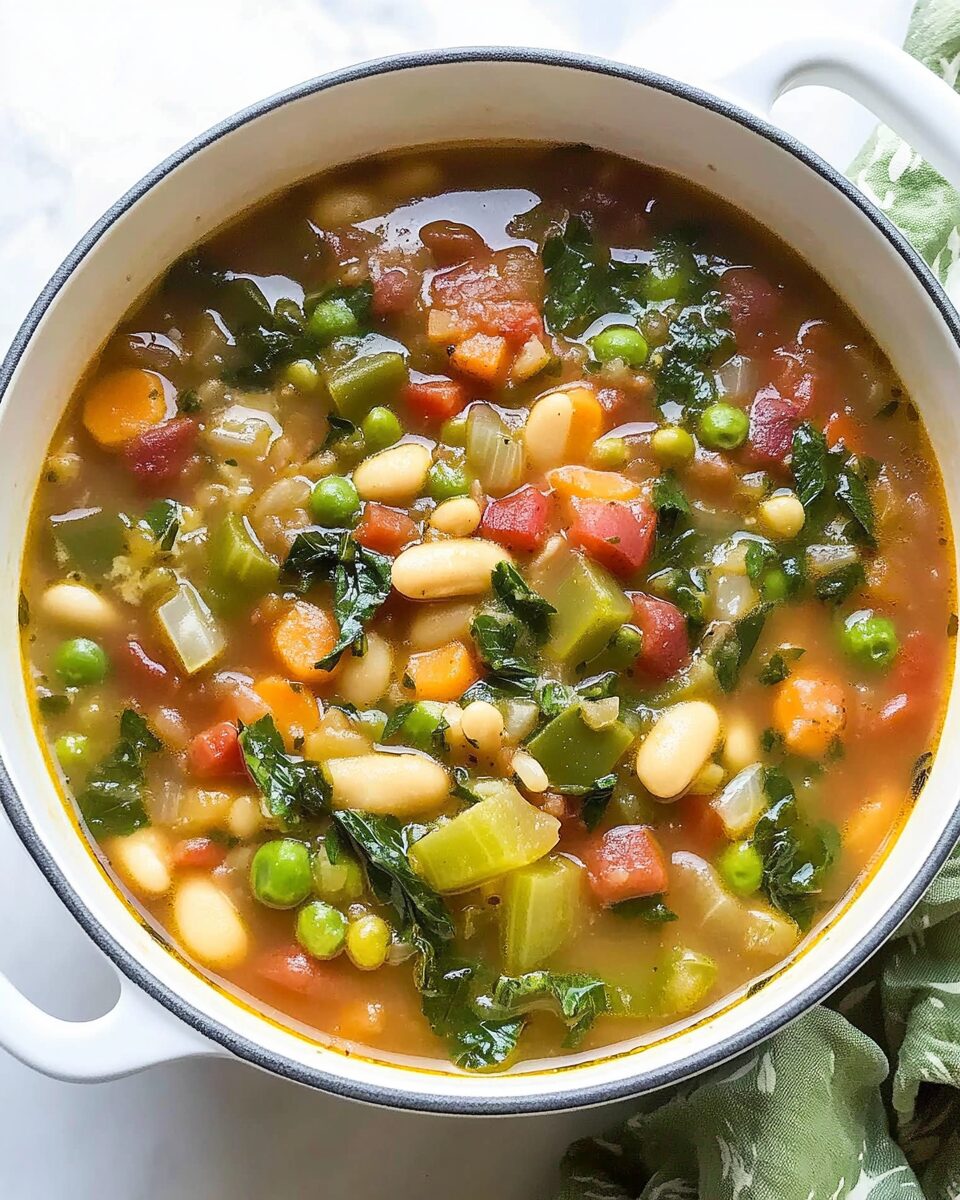This Spring Minestrone Soup is a celebration of the season in a bowl. Light, lemony, and bursting with fresh garden vegetables, it’s the perfect way to enjoy the bounty of springtime. Whether you’re trying to eat more plant-based meals or just looking for a lighter soup that doesn’t skimp on flavor, this one hits all the right notes.
The addition of pasta and beans makes it hearty enough for a full meal, while the asparagus, zucchini, and sugar snap peas add freshness and texture. A final swirl of lemon juice and basil wakes everything up, bringing balance to the broth. It’s easy, comforting, and endlessly customizable depending on what’s in your fridge or garden.
Full Recipe:
Ingredients:
-
2 tablespoons olive oil
-
1 medium yellow onion, chopped
-
2 carrots, peeled and chopped
-
2 celery stalks, chopped
-
3 garlic cloves, minced
-
1 teaspoon salt
-
1/2 teaspoon freshly ground black pepper
-
6 cups vegetable broth
-
1 can (15 ounces) cannellini beans, drained and rinsed
-
1 cup small pasta (like ditalini or elbow)
-
1 cup asparagus, cut into 1-inch pieces
-
1 cup sugar snap peas, trimmed
-
1 zucchini, chopped
-
2 cups baby spinach
-
1 tablespoon fresh lemon juice
-
1/4 cup chopped fresh basil
-
Grated Parmesan cheese for garnish (optional)
Directions:
-
Heat the olive oil in a large soup pot over medium heat.
-
Add the chopped onion, carrots, and celery. Sauté for 6-8 minutes, until softened.
-
Stir in garlic, salt, and pepper. Cook for 1 minute more until fragrant.
-
Pour in the vegetable broth and bring the mixture to a boil.
-
Add the cannellini beans and pasta. Reduce heat and simmer for 8-10 minutes or until the pasta is almost tender.
-
Stir in asparagus, snap peas, zucchini, and cook for another 5-7 minutes, until veggies are just tender but still bright.
-
Remove from heat and stir in spinach, lemon juice, and fresh basil.
-
Taste and adjust seasoning. Serve hot, garnished with Parmesan if desired.
Prep Time: 15 minutes | Cooking Time: 25 minutes | Total Time: 40 minutes
Kcal: 210 kcal | Servings: 6 servings
A Celebration of Spring in a Bowl: The Story Behind Spring Garden Minestrone with Fresh Herbs
As winter fades away and the world comes alive with color, there’s no better way to welcome the change in seasons than with a nourishing, flavor-packed bowl of Spring Garden Minestrone with Fresh Herbs. This vibrant, vegetable rich soup is not just a comforting meal it’s an edible tribute to the bounty of springtime. With its medley of crisp vegetables, tender beans, delicate pasta, and a broth that’s light yet flavorful, this dish is a seasonal essential.
Minestrone, an Italian classic, is known for its flexibility a canvas for whatever fresh produce is on hand. But what sets this spring version apart is its delicate balance of bright flavors, light textures, and the unmistakable freshness of early harvest vegetables like peas, green beans, leeks, carrots, and zucchini. It’s a soup that celebrates life, growth, and the return of warmth to the air.
The Origins of Minestrone Soup
To truly appreciate the springtime twist, it’s worth diving into the origins of minestrone. This dish has its roots in Italy, where frugality and farm to table eating have long been a part of the cultural fabric. Traditionally, minestrone was made with leftover vegetables, pasta or rice, and whatever beans or legumes were available. It’s a humble soup born out of necessity a peasant dish that was both hearty and economical.
Yet over the centuries, minestrone has evolved, becoming a beloved dish across Italy and the world. Each region has its own interpretation. In the north, you’ll find versions thickened with rice or pesto, while in the south, ingredients like tomatoes and chili flakes might dominate. And in spring, when the gardens overflow with fresh produce, minestrone transforms again this time into a lighter, greener version that mirrors the new season.
Why Spring Minestrone Is So Special
While winter soups often lean on long-cooked flavors and heavy textures, spring minestrone is all about freshness. The vegetables are barely cooked to maintain their vibrant color and a slight crunch. The broth, typically made from vegetable stock or sometimes even just water infused with aromatics, is clean and bright. Unlike a thick stew, this soup feels restorative, as if it’s recharging your body after months of heavier meals.
Another key ingredient that makes this spring version shine is fresh herbs. Mint, parsley, and basil often added just before serving give this dish a burst of aroma and an almost floral note that speaks to the time of year. These herbs don’t just serve as garnishes; they elevate the dish with a freshness that dried herbs simply can’t replicate.
Plus, the soup is incredibly adaptable. If you don’t have zucchini, add asparagus. No leeks? Try scallions. Want more protein? Toss in some shredded chicken or top with a poached egg. The beauty of this dish lies in its ability to adjust to your pantry and preferences, making it a favorite for home cooks.
A Nutritional Powerhouse
One of the most appealing aspects of Spring Garden Minestrone with Fresh Herbs is its nutritional profile. Packed with fiber-rich legumes like cannellini or garbanzo beans, it’s a fantastic source of plant-based protein. The rainbow of vegetables contributes vitamins, minerals, and antioxidants, essential for supporting your immune system especially as the seasons change and allergies or colds may flare up.
Additionally, the inclusion of whole grains or pasta offers complex carbohydrates for energy, while the herbs bring in micronutrients and even anti-inflammatory properties. Olive oil used to sauté the aromatics and drizzled over the top when serving adds healthy fats, which aid in the absorption of all those fat soluble vitamins.
It’s a well rounded, balanced dish that doesn’t sacrifice flavor for health. Instead, it showcases how the two can beautifully coexist in one comforting bowl.
Tips for Elevating Your Spring Minestrone
Even though this recipe is quite simple and straightforward, there are a few culinary tips that can take your spring minestrone from delicious to unforgettable:
-
Sauté your aromatics thoroughly: Taking the time to sweat the onions, garlic, and leeks until they’re soft and fragrant creates a more flavorful base.
-
Layer your vegetables by cooking time: Add sturdier vegetables like carrots and potatoes earlier, and tender ones like zucchini and peas later to preserve their texture.
-
Season gradually: Add salt and pepper in stages, tasting as you go. This builds a more nuanced flavor and prevents over-seasoning at the end.
-
Add the herbs at the end: Don’t simmer the fresh herbs for too long their volatile oils dissipate with heat. Stir them in right before serving to get the full burst of freshness.
-
Use good-quality broth: Since this soup is broth-forward, using a homemade or high-quality store-bought vegetable broth will make a noticeable difference in flavor.
-
Finish with flair: A final drizzle of extra virgin olive oil, a sprinkle of grated Parmesan cheese, or even a dollop of pesto can add complexity and richness to your bowl.
How to Serve It
Spring minestrone is a versatile dish that works well as a light main course or a hearty starter. Serve it with crusty bread, a simple green salad, or even a side of grilled vegetables for a complete meal. It pairs well with light white wines like Pinot Grigio or Sauvignon Blanc, which complement the soup’s herbaceous notes.
If you’re planning to serve it at a gathering, consider presenting it in a large tureen with a tray of optional toppings: grated cheese, lemon zest, fresh herbs, croutons, or even chili oil for those who like a kick. This gives your guests a chance to customize their bowl and makes the meal feel a little more special.
Perfect for Meal Prep
One of the great benefits of this soup is how well it stores. Make a big batch, let it cool, and store it in the fridge for up to 4 days. It actually tastes better the next day as the flavors meld together. It also freezes beautifully just be sure to cook the pasta separately if you’re planning to freeze, as it can become mushy when reheated.
Spring minestrone is ideal for busy weeks. Whether you’re packing lunch for work or looking for a healthy dinner after a long day, this soup is a comforting option that doesn’t compromise on nourishment.
A Dish That Reflects the Season
More than just a recipe, Spring Garden Minestrone with Fresh Herbs is an expression of the season itself. It encourages you to shop your local farmer’s market, use what’s in season, and appreciate the beauty of simple, honest ingredients. It’s a reminder that healthy eating doesn’t have to be bland or boring in fact, it can be colorful, fragrant, and deeply satisfying.
By making a bowl of this soup, you’re not just preparing a meal you’re participating in a long culinary tradition rooted in gratitude for nature’s gifts. And you’re doing it with a dish that’s as beautiful as it is delicious.
Conclusion
In the world of seasonal cooking, few dishes exemplify spring better than this light yet hearty soup. Spring Garden Minestrone with Fresh Herbs is more than just a collection of vegetables and broth it’s a celebration of the new season. It’s an invitation to eat with the earth, to relish the colors and flavors that only spring can offer, and to do so in a way that’s nourishing to both body and spirit.
Whether you’re a seasoned cook or a beginner in the kitchen, this minestrone invites creativity, flexibility, and joy. It can be adapted, customized, and reinvented endlessly just as the seasons themselves change. From its health benefits to its vibrant flavors, this dish is a must-try for anyone who loves food that tells a story.






